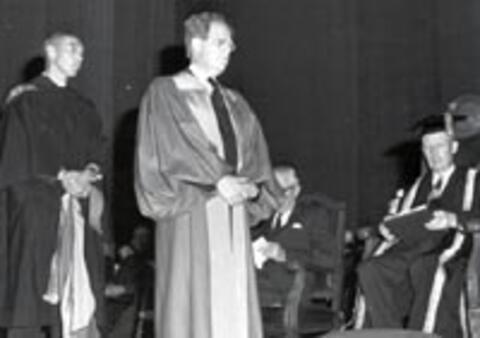
Zona do título e menção de responsabilidade
Título próprio
Honourary Degrees - Presentation - H. Northrop Frye
Designação geral do material
- Material gráfico
Título paralelo
Outra informação do título
Título e menções de responsabilidade
Notas ao título
Nível de descrição
Item
Entidade detentora
Código de referência
Zona de edição
Menção de edição
Menção de responsabilidade da edição
Zona de detalhes específicos de materiais
Menção da escala (cartográfica)
Menção da projecção (cartográfica)
Menção das coordenadas (cartográfico)
Menção da escala (arquitectura)
Autoridade emissora e denominação (filatélica)
Zona de datas de criação
Data(s)
-
14 May 1968 (Produção)
Zona de descrição física
Descrição física
1 photograph : b&w ; 17.5 x 12.5 cm
1 negative : b&w ; 12.5 x 10.0 cm
Zona dos editores das publicações
Título próprio do recurso continuado
Títulos paralelos das publicações do editor
Outra informação do título das publicações do editor
Menção de responsabilidade relativa ao editor do recurso contínuo
Numeração das publicações do editor
Nota sobre as publicações do editor
Zona da descrição do arquivo
Nome do produtor
História custodial
Âmbito e conteúdo
E.M. (Ted) Culliton, University Chancellor, making presentation of an honourary Doctor of Laws degree to H. Northrop Frye at Convocation held in Physical Education gymnasium.
Bio/Historical Note: Herman Northrop Frye was born in 1912 in Sherbrooke, Quebec. When he was seven years old, his family moved to Moncton, New Brunswick. In 1929 Frye won a typing contest and left New Brunswick to study in Toronto, where he spent most of the rest of his life. He studied philosophy and theology at the University of Toronto, and in 1936, was ordained by the United Church of Canada. He then travelled to Merton College, Oxford in England on scholarship to do his postgraduate studies, where he received an MA in English with first class honours. He returned to Canada to teach at the Victoria College (now Victoria University) at the University of Toronto. There, he was appointed chairman of the English Department, and went on to become principal (1959-1967) and finally Chancellor, a position he held until his death in 1991. Frye is considered a leading influence on the topic of literary criticism, interpreting and analyzing such complex poets as William Blake and T.S. Eliot. His first major publication Fearful Symmetry: A Study of William Blake (1947) revolutionized the way in which William Blake’s poetry came to be understood by scholars and academics. Much of Frye’s work was about archetypes, and his books and theories often drew attention to the common elements that are shared by popular stories and poems. Frye also found success in his career as an editor and as an author of articles, editing 15 books in his career and contributing chapters, essays, and articles to over 150 journals and anthologies. Frye was recognized multiple times for his achievements. In addition to his long list of publications, he was also a featured lecturer at over 100 universities worldwide, was awarded 30 honourary degrees, received the Governor General’s Literary Award for Nonfiction, and was a Companion of the Order of Canada. Northrop Frye died in Toronto in 1991. In the months and years after his death, Frye was honoured at literary conferences and academic events around the world. The U of T, where Frye studied and taught for over 60 years, maintains the Northrop Frye Centre to continue the promotion and preservation of his ideas and works. In 2000 the Frye Festival was established in Moncton to continue Northrop Frye’s legacy of literary appreciation and criticism. In 2010, the Northrop Frye School in Moncton was named for him, and in 2012, the Frye Festival erected a statue in Frye’s image outside of the Moncton Public Library.
Zona das notas
Condição física
Fonte imediata de aquisição
Organização
Idioma do material
Script do material
Localização de originais
Disponibilidade de outros formatos
Restrições de acesso
Termos que regulam o uso, reprodução e publicação
Photographer: Gibson
Other terms: Copyright: University of Saskatchewan

